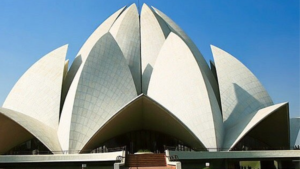The Lotus Temple : A Modern Marvel of Architecture and Spirituality Historical pllace in Delhi

Table of Contents
ToggleArchitectural Brilliance
The Lotus Temple, designed by Iranian-American architect Fariborz Sahba, is renowned for its unique lotus-inspired structure. Completed in 1986, the temple’s design draws inspiration from the lotus flower, a symbol of purity and peace in many cultures, particularly in India. The temple consists of 27 free-standing marble-clad “petals” arranged in clusters of three to form nine sides, creating a stunningly symmetrical flower shape. The white marble used for the petals was sourced from the Penteli mountain in Greece, known for its high quality and durability.
The temple stands at 34.27 meters high and is surrounded by nine pools of water, which not only enhance its beauty but also help in natural cooling. The nine doors of the temple open onto a central hall capable of holding up to 2,500 people. This hall, devoid of any idols or images, reflects the Bahá’í principle of unity and the universality of religion. The simplicity of the interior, combined with the grandeur of the structure, creates an atmosphere of tranquility and contemplation.
Symbolism and Significance
The Lotus Temple serves as a Bahá’í House of Worship, one of the seven major Bahá’í temples around the world. The Bahá’í Faith, founded in the 19th century by Bahá’u’lláh, emphasizes the unity of all religions and the oneness of humanity. This principle is embodied in the temple’s design and purpose. The lotus flower, revered in Hinduism, Buddhism, Jainism, and other Indian religions, symbolizes purity, enlightenment, and rebirth, making it a fitting motif for a place of worship that welcomes people of all faiths.
Unlike many religious structures, the Lotus Temple does not contain any ritualistic symbols, altars, or pulpits. Instead, it is a space dedicated to meditation, prayer, and the reading of scriptures from various religious traditions. This inclusive approach underscores the Bahá’í belief in the essential unity of all religions and the importance of spiritual harmony.
Cultural and Social Impact
Since its inauguration, the Lotus Temple has attracted millions of visitors from around the globe, making it one of the most visited buildings in the world. Its serene ambiance and architectural beauty have earned it numerous accolades, including several awards for its design and structure. The temple has become a major landmark in New Delhi, drawing not only those seeking spiritual solace but also architecture enthusiasts and tourists.
Beyond its architectural and spiritual significance, the Lotus Temple plays a vital role in promoting social and cultural harmony. It hosts regular interfaith meetings, discussions, and cultural events that foster dialogue and understanding among diverse communities. The Bahá’í community also engages in various social initiatives, including educational programs and humanitarian projects, furthering the temple’s mission of unity and service.
Environmental Considerations
The design of the Lotus Temple incorporates several eco-friendly features. The pools of water surrounding the temple not only enhance its aesthetic appeal but also contribute to natural cooling, reducing the need for artificial air conditioning. The temple’s large open spaces and high ceilings allow for ample natural light and ventilation, minimizing energy consumption. These thoughtful design elements highlight the Bahá’í commitment to environmental stewardship and sustainable living.
Conclusion
The Lotus Temple stands as a testament to the power of architecture to inspire and unite. Its elegant design, imbued with deep spiritual symbolism, invites contemplation and fosters a sense of peace and unity among its visitors. As a symbol of the Bahá’í Faith’s core principles of unity and inclusivity, the Lotus Temple continues to be a beacon of hope and harmony in a world often divided by differences. Whether visited for its architectural splendor, spiritual solace, or cultural significance, the Lotus Temple leaves an indelible impression on all who enter its serene embrace.
Leave a Reply